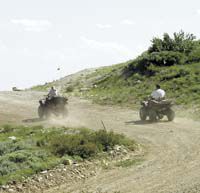| ATV riders cross Bruin Point. The 10,000-foot pass, northeast of Sunnyside and East Carbon is part of a suggested route for an OHV trail. As planning progresses, county officials have been presented with a proposal from a lobbyist on how to manage the planning and construction involved with the project. |
Carbon’s small business alliance and the county restaurant tax board have requested funding from the recreation and transportation special service district for a proposed multi-use trail through the local area.
The proposal came before the board Monday at a regularly scheduled public meeting of the Carbon County Recreation and Transportation Special Service District
Neil Breinholt, a recent appointee to the special service district, introduced the funding proposal to the board members at the July 12 meeting.
Breinholt also sits on the restaurant tax board and is part of the Carbon County Small Business Alliance.
Breinholt said that he viewed the concept as a viable economic idea.
He emphasized that if the county wishes to develop and promote the trail effectively, the planners and officials need to develop a plan that will result in a route that will attract interstate traffic.
Breinholt said one such proposal has been made by Randy Johnson, who suggested a plan for the local OHV trial which would involve five phases.
The first phase would involve the development of a plan for the trail.
In phase two, the actual construction and creation of the trail would occur.
The last three phases involve the planning and hosting of a major event on the trail, generating publicity and securing a designation for the trail from Congress.
Johnson is a former Emery County commissioner who was involved in the proposed San Rafael Swell National Monument, which was struck down in the 2002 election.
Johnson currently operates a lobbyist firm, Government Matters.
“We’re looking at a long-term comprehensive master plan,” said Johnson.
The proposal focused primarily on OHV use, one of many suggested uses for the route.
In the proposal presented to the special service district, Johnson outlined phase one specifics and requested $56,000 for the work involved with that phase.
The two remaining stages of the project would be dependent on the research and discovery made in phase one.
The figure for the costs of phase one raised concern among the county’s special service district board members, who said they were somewhat uncomfortable about spending money on a proposal that did not delineate the itemized costs of the service that would be offered.
In addition, the special service district board members voted at the panel’s last meeting to advertise for an agent to secure the rights of way along the route.
The advertisement started running on Tuesday and the proposals from interested parties will not be reviewed until Aug. 1.
Most of the work already completed on the county’s concept for the OHV route has been done by the county’s planning department. That department is overwhelmed with their present work load.
All three county commissioners attended the meeting and gave input as the board discussed the proposal.
Commissioner Mike Milovich pointed out that he had not seen the current plans for the project, and neither had a number of elected officials in cities throughout the county.
With those concerns recognized, no one on the board would second a motion made by Breinholt to accept the proposal. However, the board recognized that the proposal was worthy of consideration.
“This is the most positive thing that’s been toward a trail system. We can’t let it die,” said board member Sam Quigley.
After lengthy discussion over the proposal, the board voted in favor of a revised motion by Breinholt. The board scheduled a special meeting to review the proposal with city and county elected officials. That meeting will be on July 18. If elected officials do not find conflicts with the proposal, the board will then reconsider it.
In addition, a breakdown of the costs associated with phase one will be required before the special service district funds the proposal.
In an unrelated matter, the board voted to release funds in the amount of $80,000 to the College of Eastern Utah Prehistoric Museum.
The director of the museum, Reese Barrick, explained that the museum is now looking at the option of relocating to a new facility.
Previous plans for the museum had included a major expansion at the current location.
Barrick said that the museum is seeing a greater number of visitors. The last time the museum had seen that number of visitors was in 2000, prior to the slump in visitation that occurred in the recession since then.
The museum is reviewing a number of sites. Some of those are within Price city limits, while others are not. Barrick said the more favorable ones are outside the city.
He also said that when the museum moved, the facility could be easily used for another purpose. He said that other entities are looking at potential uses for the current building.
The $80,000 will cover the costs of the planning up to this point. An additional $80,000 has been offered by the special service district if the museum needs it.

